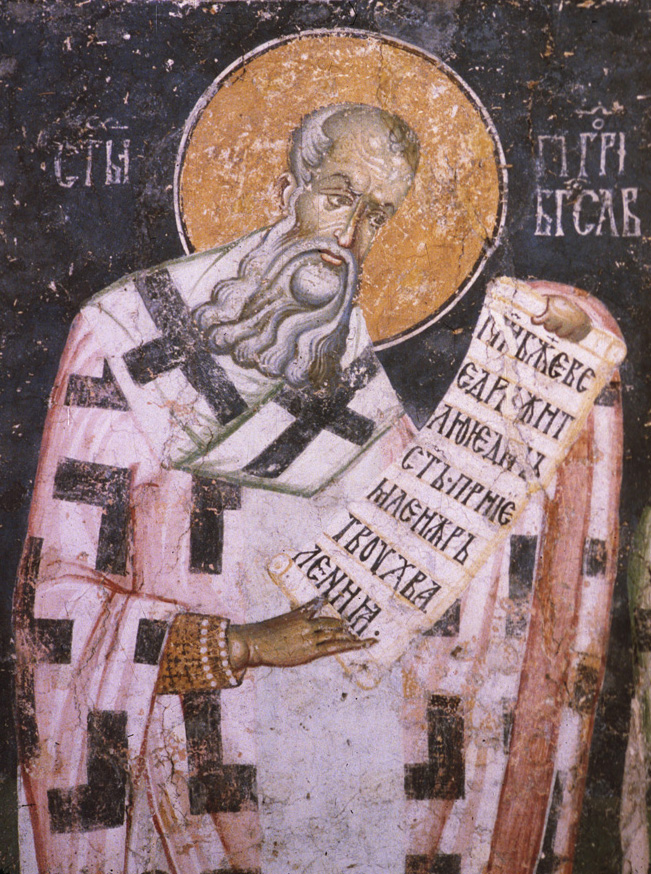
Fresco of St. Gregory the Theologian, Church of the Holy Apostles, Monastery of the Patriarchate of Pec, ca. 1260.
Concerning the Canon of the Holy Bible according to
"Gregory the Theologian was a contemporary of Basil the Great, and was ordained by him Bishop of Sasima. Upon leaving Sasima he undertook the care of the Church in Nazianzus, in his own fatherland, in obedience to the father Gregory. In the year 378 he was sent to Constantinople by the Council convened in Antioch, in order to take assiduous care of the Orthodox. After resigning the presidency of the Imperial City which had been entrusted to him by Theodosius the Great, he came before the Second Ecumenical Council, to Arianzon, a town near Nazianzus (also there), having versified many poetical compositions, in the year 391 after Christ, his age being, according to Fabricius, 91 when he terminated the perishable life." (Rudder, p. 883)

Fresco of St. Gregory the Theologian, Church of the Holy Apostles, Monastery of the Patriarchate of Pec, ca. 1260.
“Be not disposed to treat books with the mind of thief,
For there are many pieces of viciousness interpolated therein.
“Accept this number, my friend, from me as the approved list:
Of historical books there are but twelve all told;
“They are the products of the most ancient Hebrew wisdom.
The first one is Genesis, then comes Exodus, then Leviticus,
“Followed by Numbers, next by Deuteronomy, or the Second Law,
After which come Joshua, and Judges, and Ruth, which is the eighth;
“The ninth and tenth books are the Acts of the Kings;
Then come the two Chronicles, and lastly thou hast Ezra.
"The poetical books are five, of which the first is Job,
The next is David, followed by the three books of Solomon,
“Ecclesiastes, the Song of Songs, and Proverbs.
And five likewise are of a prophetic spirit.
“One book in Scripture is formed of twelve as follows:
Hosea, and Amos, and Micah, which is the third one;
“Afterwards come Joel, then Jonah, and then Obadiah;
The next ones are Nahum, and Habakkuk, and Zephaniah;
“The last three of them are Haggai, and Zechariah, and Malachi.
These forming one book, the second book is Isaiah.
“Afterwards comes the one called Jeremiah in his infancy,
Next thereafter Ezekiel and the grace of Daniel.
“Of the ancient Scripture I have listed twenty-two books;
These writings of the Hebrews are opposed by twenty-two others.
“Now let us count those of the New Mystery:
Matthew wrote the miracles of Christ to the Hebrews.
“Mark wrote them to Italy, Luke to Achaias,
And to all men John the great preacher who visited heaven.
“Afterwards come the Acts of the wise Apostles,
Ten books are Paul’s, and so are four Epistles.
“There are seven Epistles Catholic, of which that of James is one,
Two are those of Peter, and three are those of John again.
“The seventh is that of Jude, and you have them all.
If any be found outside of these, they are not genuine.”
(Rudder, pp. 883-884)